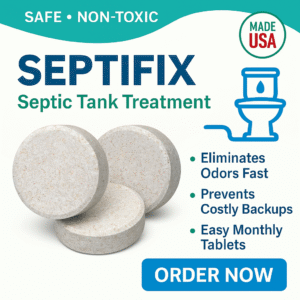Got a stubborn clogged toilet and worried about your septic system? If you’re dealing with a blockage, it’s important to fix it without damaging your septic tank or killing the good bacteria inside. The good news: with the right tools and approach, you can clear most clogs safely and avoid a costly call to the plumber. Here’s how, plus the best products for septic-friendly toilet unclogging.
Quick Picks: Top Tools for Unclogging Toilets on Septic Systems
-
Best Overall:
SimpleHuman Professional Toilet Plunger & Caddy -
Best Budget:
Drano Max Build-Up Remover (Septic-Safe) -
Best Premium:
RIDGID 59787 K-3 Toilet Auger (3-Feet)
Buyer’s Guide: Safe Ways to Unclog a Toilet with a Septic System
- Skip Harsh Chemicals: Never use caustic drain openers (like lye, bleach, or acid) in a septic system. They can kill beneficial bacteria and harm your pipes.
- Use a Plunger First: A quality plunger with a flange is safe, fast, and effective for most basic clogs.
- Try a Toilet Auger: For stubborn blockages, a toilet auger (also called a closet snake) can break up clogs without scratching porcelain or harming your system.
- Consider Septic-Safe Enzyme Cleaners: Enzyme-based drain cleaners are gentle on pipes and your septic tank—great for slow drains or minor buildup, but not for total blockages.
- Flush Wisely: Never flush wipes, hygiene products, grease, or excessive paper. Prevention is the best cure for septic clogs!
If a clog won’t budge after trying the above, call a licensed plumber—never keep flushing or add harsh chemicals.
Full Reviews: Best Septic-Safe Toilet Unclogging Tools & Products (2025)
SimpleHuman Professional Toilet Plunger & Caddy
Who it’s for: Anyone who wants a powerful, durable plunger that looks good and works fast.
- Key Benefits:
- Strong, high-quality rubber for quick plunging
- Narrow flange fits all toilets (including low-flow models)
- Includes sanitary caddy for easy storage
- Pros:
- Works better than cheap plungers
- Easy to clean and hides away neatly
- Won’t damage porcelain or seals
- Cons:
- Pricier than big box store models
- Handle is not telescoping
Final Verdict: An excellent, reliable first step for any septic-safe clog fix.
Get SimpleHuman Plunger.
Drano Max Build-Up Remover (Septic-Safe)
Who it’s for: Anyone who wants an easy, chemical-free way to keep drains clear and help prevent clogs before they start.
- Key Benefits:
- Uses natural enzymes and bacteria—safe for all septic tanks
- Breaks down organic waste and helps prevent slow drains
- No caustic or corrosive chemicals
- Pros:
- Safe for all pipes and tanks
- Works for all household drains, not just toilets
- Great value per bottle
- Cons:
- Won’t work on total blockages—best as a monthly treatment
- Requires overnight use for best results
Final Verdict: Best value for routine drain care and septic protection.
Shop Drano Septic-Safe.
RIDGID 59787 K-3 Toilet Auger (3-Feet)
Who it’s for: Anyone dealing with a stubborn toilet clog or recurring blockages.
- Key Benefits:
- 3-foot flexible cable easily clears deep or tough clogs
- Vinyl guard protects toilet from scratches
- Professional-quality construction
- Pros:
- More effective than a plunger for hard clogs
- Safe for septic and all drain pipes
- Built to last for years
- Cons:
- Requires some practice for best results
- More expensive than plungers
Final Verdict: The top choice when plungers just aren’t enough.
Order RIDGID Auger.
Comparison Table: Septic-Safe Toilet Unclogging Solutions
| Name | Key Features | Specs/Capacity | Price Link |
|---|---|---|---|
| SimpleHuman Plunger | Professional-grade, sanitary caddy | Standard size, fits all toilets | View Price |
| Drano Max Build-Up Remover | Enzyme-based, septic-safe | 64 oz bottle | View Price |
| RIDGID K-3 Toilet Auger | 3 ft cable, vinyl guard | Heavy-duty steel | View Price |
Frequently Asked Questions (FAQ)
Is it safe to use regular drain cleaners on a septic system?
No. Most chemical drain cleaners are too harsh for septic tanks. They can damage your system and kill off the bacteria you need for waste breakdown.
What’s the best DIY way to unclog a toilet if you have a septic tank?
Use a flange-style plunger first. If that doesn’t work, try a toilet auger. Avoid chemical drain openers and keep septic bacteria healthy.
Are enzyme or bacteria-based cleaners safe for septic systems?
Yes. Enzyme-based products (like Drano Max Build-Up Remover) are gentle and help keep pipes clear without harming your septic tank.
What if nothing works?
If the toilet is still clogged after plunging and augering, call a plumber. Never keep flushing, as it could overflow and harm your septic or home.
How can I prevent toilet clogs on a septic system?
- Don’t flush wipes, feminine products, or anything except toilet paper and waste
- Limit toilet paper per flush
- Treat pipes monthly with septic-safe enzyme cleaner
Conclusion & Call to Action
Unclogging a toilet on a septic system is simple when you have the right tools—and know what NOT to use. Avoid harsh chemicals, grab a quality plunger or auger, and keep your septic system healthy for years to come.
Ready to clear that clog the septic-safe way? Pick one of the recommended tools above and restore your peace of mind today!
